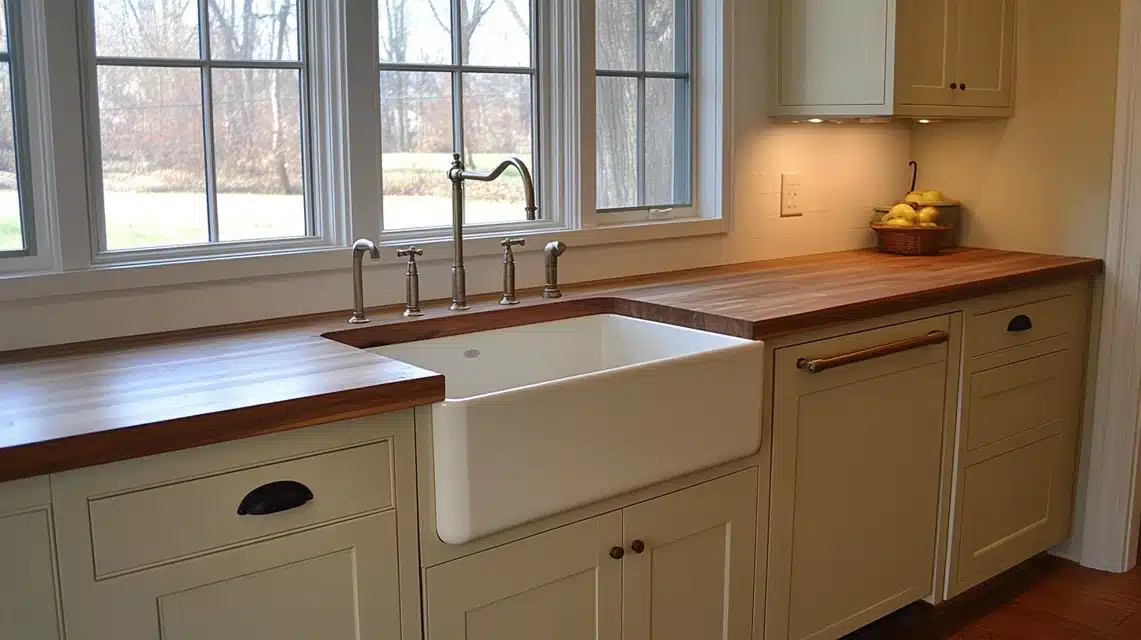How to Install a Farmhouse Sink: Replacing Existing Sink
Do you want to know how to install a farmhouse sink? Replacing a kitchen sink with a farmhouse sink can completely change the look of your kitchen while adding practicality.
I recently tackled this project and learned a lot along the way. Farmhouse sinks are heavy and require proper preparation, but with the right tools and steps, you can handle it yourself.
It’s all about taking one step at a time, from removing the old sink to modifying cabinets and installing plumbing.
In this guide, I’ll walk you through the process and share tips to make it easier. Let’s get started!
Guide to Replacing a Kitchen Sink with a Farmhouse Sink
Step 1: Gather Materials Required
For Removing the Existing Sink:
- Utility knife (for cutting silicone)
- Jack (for lifting the sink)
- Adjustable wrench (for disconnecting water lines and drain)
- Towels or a bucket (to catch any residual water)
For Cabinet and Frame Modifications:
- 2×4 lumber (for building the sink support frame)
- Screws (to secure the frame and cabinet modifications)
- Drill and drill bits
- Measuring tape
- Level (to ensure the frame and sink are even)
- Saw (for cutting lumber to size)
For Plumbing Adjustments:
- New sink drain assembly
- Plumbing kit (for adjusting to a single drain)
- Pipe fittings and connectors (as needed)
- PVC pipes and trap
- Teflon tape (to ensure leak-proof connections)
- Wrench or pliers (for tightening plumbing connections)
For Cabinet Finishing:
- Paint (to match the existing cabinets)
- Paintbrush or roller
- Caulk (to fill gaps and screw holes)
- Sandpaper (for smooth finishing before painting)
- Plywood (if making new cabinet doors)
For Faucet and Soap Dispenser Installation:
- Faucet (reuse the old one or a new one)
- Soap dispenser (reuse the old one or a new one)
- Forstner bit (for drilling holes in the countertop)
For Sink Sealing:
- Silicone sealant (to prevent water leakage)
- Caulk gun (for applying silicone)
Step 2: Prepare to Remove the Existing Sink
- Cut around the edges of the existing sink using a knife to remove as much silicone as possible.
- Disconnect the water lines and drain, as the faucet is attached to the sink.
Step 3: Carefully Remove the Sink
- Place a jack underneath the sink to lift it slightly while continuing to cut away the silicone.
- Ensure the sink is completely free of silicone and any other attachments before lifting it out.
- Remove the faucet if it will be reused for the new sink.
Step 4: Check Cabinet Compatibility
- Assess the countertop and cabinets to ensure they can accommodate an apron sink.
- If the cabinets are outdated (e.g., built in the 60s), rework or replace them to fit the new sink.
Step 5: Build a Support Frame
- Construct a sturdy frame using 2x4s to support the weight of the heavy apron sink.
- Include two legs on either end and a crossbar on top for the sink to rest on.
- Add additional 2x4s across the frame for extra support, ensuring everything is level.
Step 6: Install the Sink
- Slide the sink into place on the frame.
- Secure the sink by adding a board across the back to prevent it from shifting backward.
Step 7: Rebuild Cabinet Fronts
- Reframe the cabinet front if the opening is too small or doesn’t align with the new sink.
- Resize or build new cabinet doors if necessary.
Step 8: Install Plumbing
- Replace the old drain with a new one.
- If the previous sink had multiple drains, adjust the plumbing setup to fit the apron sink’s single drain.
- Install a new kit for the plumbing trap as required.
Step 9: Apply Finishing Touches to Cabinets
- Paint the cabinet frames and doors to match the rest of the kitchen.
- Fill screw holes and cracks with caulk for a seamless look.
Step 10: Install the Faucet and Soap Dispenser
- Drill holes in the countertop for the faucet and soap dispenser.
- Ensure the holes are centered with the sink and drain for proper alignment.
- Reinstall the faucet and soap dispenser from the old sink.
Step 11: Seal the Sink
- Apply a bead of silicone between the sink and countertop to prevent water from dripping into the cabinet below.
- Clean up the area and test all connections to ensure no leaks. Enjoy your newly installed apron sink!
Download the “How to Install a Farmhouse Sink” Guide PDF
CLICK HERE
Summing Up
Replacing your kitchen sink with a farmhouse sink may seem like a big task, but breaking it into manageable steps makes it achievable.
Here’s a quick recap of the main points covered:
- Gather materials and tools before starting.
- Remove the old sink carefully, cutting through the silicone and disconnecting the plumbing.
- Build a sturdy frame to support the heavy sink.
- Modify cabinets to ensure a proper fit.
- Install new plumbing and finish the cabinets for a polished look.
- Add the faucet and soap dispenser, and seal the sink for a complete finish.
Now, enjoy your stunning new farmhouse sink!
Frequently Asked Questions
Are Farmhouse Sinks Easy to Install for DIYers?
Farmhouse sinks can be challenging to install for DIYers. Due to their size and weight, they require proper tools, cabinetry modifications, and heavy lifting.
What are the Differences Between Installation Methods (Undermount vs. Top Mount)?
Undermount sinks sit below the countertop for a seamless look, while top-mount sinks rest on the countertop, offering easier installation but a more visible edge.
How Do I Maintain and Clean a Farmhouse Sink After Installation?
Use mild soap and water daily, avoid harsh chemicals, and dry the sink to prevent water spots. To clean stains gently, use baking soda or vinegar.
Do I Need a Special Cabinet for a Farmhouse Sink?
Farmhouse sinks require a reinforced cabinet with appropriate dimensions and support, as they are heavier and differ from traditional sink installations.







